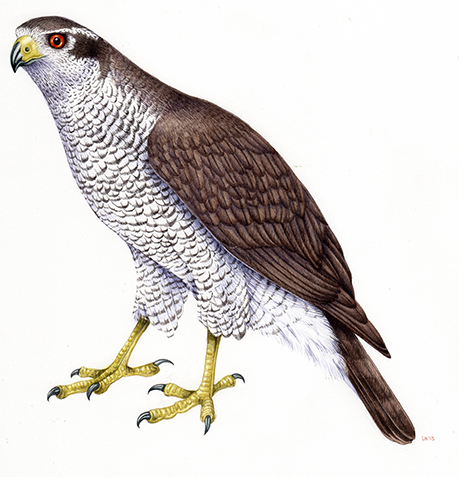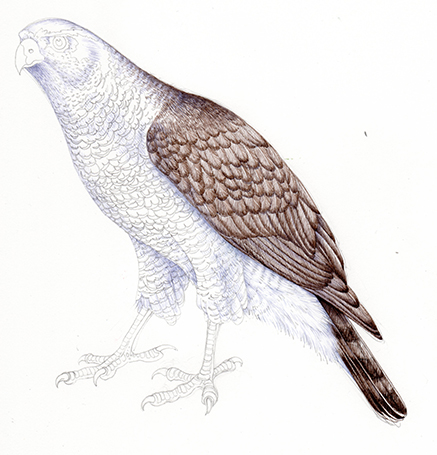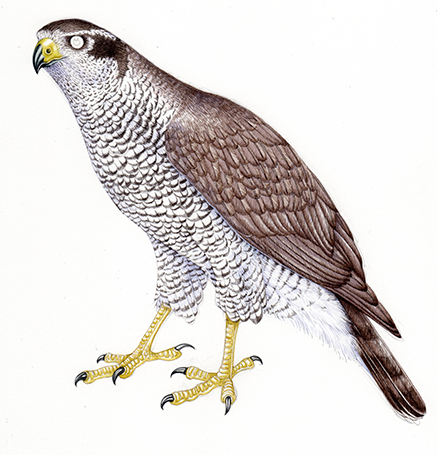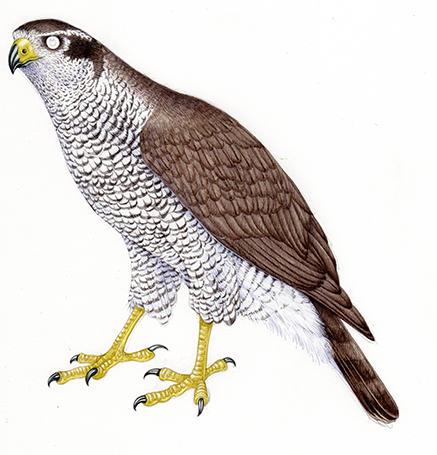Natural History Illustration of the Goshawk

After a lot of recent botanical illustration, it was a treat to be commissioned to do an ornithological natural history illustration of the Goshawk Accipiter gentilis for a private client.
The Goshawk is a gorgeous bird of prey, and has long been used in falconry. They’re really hard to spot, and are fearsome predators. (A recent and beautiful book on the Goshawk is well worth a read; H is for Hawk by Helen Macdonald) Therefore, getting good reference for them is very tricky. Luckily I had permission from some top ornithology photographers to use their photos for reference purposes, and thus could get the information I needed.
Drawing up the pencil rough
After drawing up the Goshawk in pencil (I like mechanical pencils like the Pentel P205) onto watercolour paper, I struggled with the feet. All the ref. I had showed the talons partially obscured. Using a hopeful outlook, a bit of biological knowledge, and various different sources of reference I pieced the hawk’s feet together. Even now I feel this is the weakest part of the illustration.
Painting the darkest areas of the Goshawk feathers
Next I plot in the structure and texture of the feathers using a mix of Vandyke brown, yellow ochre, sap green, cobalt blue, purple, cadmium orange light, and cerulean blue (no, it really did take all of them to get near the correct shade of brown!). Generally I stick to Winsor & Newton watercolours, and needed to throw out my old number 1 series 7 brush in favour of a new one for this job. As I build up the feathers with repeated tiny strokes, I try to give extra weight to one side of each feather as this gives depth and texture to the wings.
I also work into the white feathers by suggesting shadows. These have to be bold in colour to ensure the feathers look white when the illustration is complete, and I use a mix of cobalt blue and violet, very watery and lightly applied.

A unifying brown wash goes onto the wing area – Vandyke brown mixed with yellow ochre and lots of water. I suggest the central rachis of each feather on the wing. Mixing Vandyke brown with a violet and a deep greenish blue, I paint in the beautiful chest feathers. Tiny little brush strokes are needed, and again I try to put more weight on one side of each feather. I believe I made the Goshawk chest region too dark and not quite as stripy as it should be; an example of slightly overworking a painting.
Illustrating the feet and beak
After so much feathery work, it’s a relief (and a challenge) to plot in the bright yellow expanses of the bird’s beak, and to start building up the structure of the legs. It’s an alarmingly bright yellow, so I used cadmium yellow light and Indian yellow with only a touch of yellow ochre to knock it back.
Getting the murderously sharp point of the beak and the claws acute enough inevitably proves a real challenge, and I find I stop breathing as I paint the tiny dark lines that suggest these apexes.

More washes build up, the wing and tail feathers took about five increasingly dark washes before they started to look like they had any depth. I work further into the purple of the shadows under the wing and on the rear leg, and paint in shadows on the tail. More tiny strokes give a better sense of form to the back of the hawk’s neck and to his facial markings.
A yellow wash is applied to the legs, and I work further into the beak and claws.
Painting the eye and completing the illustration

I always leave the eye til last, I always have done. This was tricky, as every written description talked about the fierce red eye of the adult male goshawk; but none of the photos or illustrations showed the bird with anything other than a yellow eye. I decided to go with the written ornithological descriptions, but err on the side of caution by making certain there were plenty of yellow highlights within the depth of the iris.
Another couple of brown washes on the wings and tail, and a little more work on the shadows on the legs, tail, and superciliary area saw the bird nearing completion. A bit more work on the pupil (always the hardest part of a painting to get right), and a touch more dark on both talons and beak, and the bird was complete.


